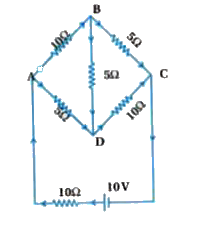The potential at point D is = ....... as shown In below figure.

(a) 12(V1+V2)
(b) C1V2+C2V1C1+C2
(c) C1V1+C2V2C1+C2
(d) C2V1−C1V2C1+C2 Solution in Gujrati
12(V1+V2)
C1V2+C2V1C1+C2
C1V1+C2V2C1+C2
C2V1−C1V2C1+C2
The correct Answer is:A, B, C
Suppose electric potential at D is V.
∴V1−V=qC1 and V−V2=qC2
( both are in series )
∴V1−VV−V2=C2C1
∴V1C1−VC1=VC2−V2C2
∴V1C1=V(C1+C2)
∴V=V1C1+V2C2C1+C2
Topper's Solved these Questions
- BOOK - KUMAR PRAKASHANCHAPTER - ELECTROSTATIC POTENTIAL AND CAPACITANCEEXERCISE - Section D ( MCQs asked in Cometitive Exams )39videos
ELECTROSTATIC POTENTIAL AND CAPACITANCE
- BOOK - KUMAR PRAKASHANCHAPTER - ELECTROSTATIC POTENTIAL AND CAPACITANCEEXERCISE - Section C ( NCERT Exemplar Solution ) ( Long Answer Type Questions )12videos
ELECTROSTATIC POTENTIAL AND CAPACITANCE
- BOOK - KUMAR PRAKASHANCHAPTER - ELECTROMAGNETIC WAVESEXERCISE - BOARD.S QUESTION PAPER MARCH - 2020 (PART - B) SECTION - C5videos
ELECTROMAGNETIC WAVES
- BOOK - KUMAR PRAKASHANCHAPTER - MAGNETISM AND MATTEREXERCISE - SECTION D Multiple Choice Questions (MCQs) (MCQs asked in Competitive Exams) MCQs asked in Board Exam and GUJCET7videos
MAGNETISM AND MATTER
Similar Questions
Capacitance of a capacitor 100 μ F. The work is done for depositing chargc 8×10−18 C on it will be .........
02:24View SolutionFind the equation of the equipotential for an infinite cylinder of radius r0 carrying charge of linear density λ.
01:28View SolutionDetermine the current in each branch of the given network.
 03:06View Solution
03:06View SolutionAt a place on earth the vertical component of earth's magnetic field is √3 times its horizontal component. The angle of dip at this place is …...
05:24View SolutionThree capacitors C_(1),C_(2) and C_(3) are connected as shown in, The potentials of P,Q , and R are V_(1),V_(2), and V_(3) , respectively. Find the potential V_(0) at the function O . .
09:49View SolutionFor section AB of a circuit shown in , C_(1)=1 muF, C_(2)=2 muF, E=10 V , and the potential difference V_(A)-V_(B)=-10 V . Charge on capacitor C_(1) is .
04:08View SolutionThe capacities of two conductors are C_(1) and C_(2) and their respectively potentials are V_(1) and V_(2) . If they are connected by a thin wire, then the loss of energy will be given by
04:49View SolutionThree uncharged capacitors of capacities C_(1),C_(2) and C_(3) are connected as shown in the figure to one another and the potentials V_(1),V_(2) and V_(3) respectively. Then the potential at O will be .
02:55View SolutionThe capacities of two parallel plate capacitors are C1 and C2 and their respective potential are V1 and V2. If they are connected by a thin wire, then
(A) Commen potential will be C1V1+C2V2C1+C2, if plates of same polarities are connected together
(B) Loss of energy will be 12C1C2C1+C2(V1−V2)2, if plates of same polarities are connected together
(C) Common potential will be |C1V1−C2V2|C1+C2, if plates of opposite polarities are connected together03:51View SolutionTwo capacitors C_(1) and C_(2) in a circuite are joined as shown. If V_(A)=V_(1),V_(B)=V_(2) , the potemntial of point P is
02:33View SolutionTwo capacitors C_(1) and C_(2) are connected in a circuit as shown in figure. The potential difference (V_(A) - V_(B)) is
04:50View SolutionTwo capacitors with capacities C1 and C2 ,are charged to potentials V1 and V2 respectively.When they are connected in parallel,the ratio of their respective charges is ....?
03:21View Solutionनिम्न चित्र में बिन्दु 0 का विभव C1,C2,C3,VA,VB एवं VC के पदों में ज्ञात कीजिए।
 02:29View Solution
02:29View SolutionTwo capacitors in one circuit C_(1) And C_(2) Is added as shown in Fig. V_(1) And of B V_(2) Will have potential
03:52View SolutionIf capacity C_(1), = 2C_(2) = 2C_(3) And maintainers C_(1),C_(2) and C_(3) Respectively at the ends of v_(1),v_(2) and v_(3) is
02:59View Solution

